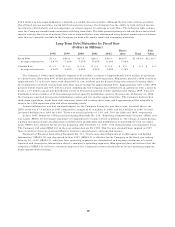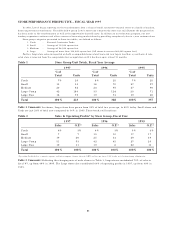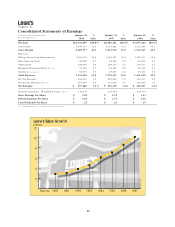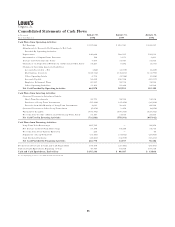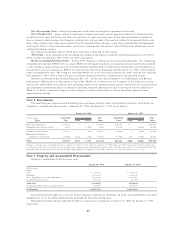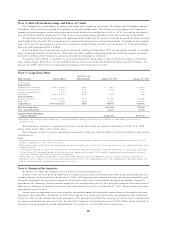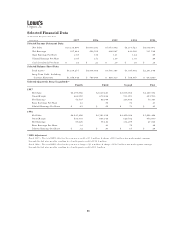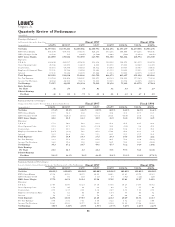Lowe's 1997 Annual Report Download - page 32
Download and view the complete annual report
Please find page 32 of the 1997 Lowe's annual report below. You can navigate through the pages in the report by either clicking on the pages listed below, or by using the keyword search tool below to find specific information within the annual report.
right on each outstanding share of common stock. Each purchase right will entitle shareholders to buy one unit of a newly
authorized series of preferred stock. A shareholder’s interest is not diluted by the effects of a stock dividend or stock split. At
the time of adopting the rights plan, each unit was intended to be the equivalent of one share of common stock. The purchase
rights will be exercisable only if a person or group acquires or announces a tender offer for 20% or more of Lowe’s common
stock. The purchase rights do not apply to the person or group acquiring the stock. The purchase rights will expire on
September 19, 1998.
The Company has two stock incentive plans, referred to as the “1994” and “1997” Incentive Plans, under which incentive
and non-qualified stock options, stock appreciation rights, restricted stock awards and incentive awards may be granted to
key employees. No awards may be granted after January 31, 2004 under the 1994 plan and 2007 under the 1997 plan. Stock
options generally have terms ranging from 5 to 10 years, vest evenly over 3 years and are assigned an exercise price of not
less than the fair market value on the date of grant. At January 30, 1998, there were 23,790 and 4,303,750 shares available
for grants under the 1994 and 1997 plans, respectively.
Option information is summarized as follows:
Weighted-Average
Key Employee Stock Option Plans Shares Exercise Price Per Share
(In Thousands)
Outstanding January 31, 1995 and 1996 20 $38.75
Canceled or Expired (10) $38.75
Granted 1,215 $39.13
Outstanding January 31, 1997 1,225 $39.12
Granted 747 $45.09
Canceled or Expired (10) $39.13
Exercised (2) $39.13
Outstanding January 30, 1998 1,960 $41.40
Exercisable January 30, 1998 417 $39.12
Of the 1,960,000 options outstanding at January 30, 1998, the exercise prices per share range from $38.75 to $47.31
and their weighted-average remaining term is 4.2 years.
Stock appreciation rights are denominated in units, which are comparable to a share of common stock for purposes of
determining the amount payable under an award. An award entitles the participant to receive the excess of the final value of
the unit over the fair market value of a share of common stock on the first day of the performance period. The final value is
the average closing price of a share of common stock during the last month of the performance period. Limits are established
with respect to the amount payable on each unit. A total of 496,050 stock appreciation rights, with performance periods of
three years and a maximum payout of $3,720,375, were outstanding at January 30, 1998. The costs of these rights are being
expensed over the performance periods and have reduced pre-tax earnings by $0.9, $1.0 and $1.0 million in 1997, 1996 and
1995, respectively.
Restricted stock awards of 435,350, 388,550 and 133,500 shares, with per share weighted-average fair values of $49.61,
$33.14 and $31.25, were granted to certain executives in 1997, 1996 and 1995, respectively. These shares are nontransferable
and subject to forfeiture for periods prescribed by the Company. These shares may become transferable and vested earlier
based on achievement of certain performance measures. During 1997, a total of 20,200 shares were forfeited and 39,750 shares
became vested. At January 30, 1998, grants totaling 991,900 shares are included in Shareholder’s Equity and are being amor-
tized as earned over periods not exceeding seven years. Related amortization expense for 1997, 1996 and 1995 was $6.2,
$1.9 and $0.6 million, respectively.
The Company has a Directors’ Stock Incentive Plan. This Plan provides that at the first Board meeting following each
annual meeting of shareholders, the Company shall issue each non-employee Director 500 shares of common stock. Up to
25,000 shares may be issued under this Plan. In 1997, 1996 and 1995, 4,000, 4,000 and 3,500 shares, respectively, were
issued under this Plan. Prior to its expiration in 1994, 140,000 stock options were issued under a Non-Employee Directors’
Stock Option Plan. At January 30, 1998, 68,000 shares have been exercised and 72,000 shares were exercisable. Of the
remaining outstanding options at January 30, 1998, the exercise price per share ranges from $6.375 to $18.875 and their
weighted-average remaining term is 3.5 years.
The Company applies APB Opinion No. 25, “Accounting for Stock Issued to Employees,” and related interpretations in
accounting for its stock options plans. Accordingly, no compensation expense has been recognized for stock-based compen-
sation where the option price of the stock approximated the fair market value of the stock on the date of grant, other than for
restricted stock grants and stock appreciation rights. No stock options were granted in 1995. Had compensation for 1997
and 1996 stock options granted been determined consistent with Statement of Financial Accounting Standards No. 123
30


